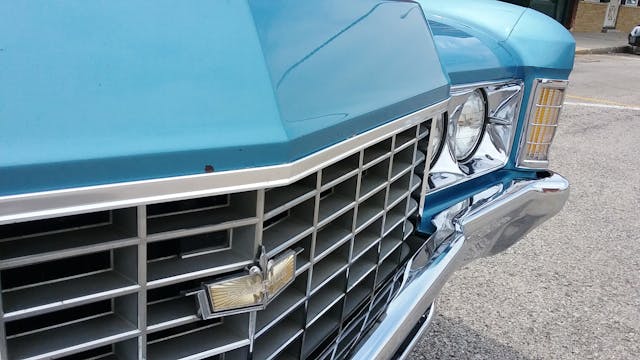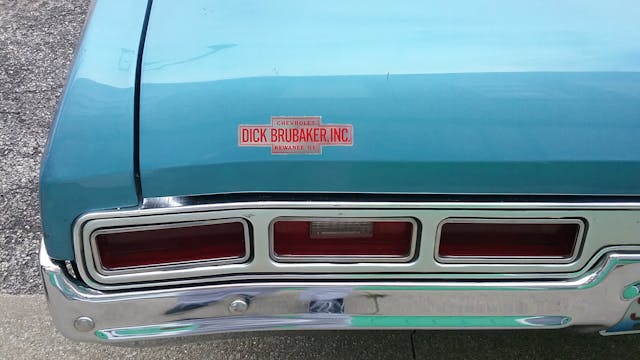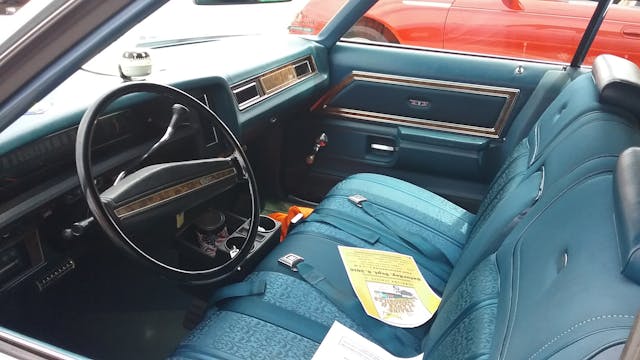Media | Articles
1971 Chevrolet Caprice: Chevy goes Brougham!

I’ve always loved the Chevrolet Caprice. Maybe because two of our neighbors had 1977 Caprice Estate Wagons, and they were always parked right in front of our house. Also, as a child of the ’80s, I had a number of Caprice and Impala toy police cars. And they were everywhere, both on the streets and in the movies of the time, frequently as NYC taxis or police cars.
But those were the downsized 1977–90 versions, not the subject of today’s column. The Nimitz-class 1971 Caprice. As I’ve related in earlier columns, the 1971 B- and C-body GM cars were all completely redesigned and became even bigger than the previous GM full sizers. And this was as big as they were going to get: the 1971–76 Chevys were the last of the unabashedly FULL-SIZE cars, along with their Bonneville, Delta 88, and LeSabre brethren.
But wait, you might be saying, Chevy went Brougham back in 1965 with the original Caprice, right? Yes. All true, but personally I’ve always considered the 1971 Caprice to be truly Broughamy, perhaps peak Brougham for the luxury Chevrolet nameplate. While the 1965–70 Caprices were extremely nice and luxurious, the ’71 was approaching Cadillac territory.
For the first time, Caprice received its own distinct front-end styling, with a bold eggcrate grille with inset Caprice fleur de lis emblem placed front and center. Up until 1971, Caprices shared the same nose with its Impala and Bel Air brethren. Now everyone knew you had the top-dog Chevy whether you were coming or going.
And with their wide-chrome, full-length rocker trim, “electric range” deluxe wheel covers, and fender skirts, they gave a pretty healthy Cadillac vibe, with the exception of their traditonal upper-class Chevrolet sextuplet of horizontal taillights. Granted, all the new ’71 GM biggies had a family resemblance, but the Caprice really had an upper class vibe—especially from the front.
Marketplace
Buy and sell classics with confidence
There was a lime green metallic Caprice (Cottonwood Green, I believe, now that I’m looking at my ’71 Caprice brochure) in our neighborhood back then, too. I’m not sure who it belonged to, but it was usually parked catty-corner from our house. A couple of its original wheel covers had been replaced with circa 1971–72 Oldsmobile units, but the passenger side still retained those original, oh-so-cool electric range discs.
So that could be why I lit up like a Christmas tree when I saw this GORGEOUS example at the annual Cambridge, Illinois, car show in August 2018. I’d seen it at an earlier show in 2013, but didn’t take as many pictures as it was kind of boxed in on both sides.
But Eureka! It was sitting all by its lonesome this time, so I was able to take approximately 15–16 photos of it, including this side shot that shows the 1971 Caprice’s majestic Broughamage, and how it appears to be 30 feet long (ha ha). Standard equipment included a 255-horsepower 400 V-8. The 365-hp Turbo-Jet 454 V-8 was optional for extra spirited motorists.
As the 1971 brochure spelled out, “Caprice. Probably the most inexpensive expensive car ever built.” It certainly looked the part inside and out, with fine fabrics, ample space, and chrome, chrome, chrome. Interiors came in a choice of five colors.
The Caprice came only as two- and four-door hardtops; the convertible would not come along until 1973, so topless fans would have to settle for an Impala drop top. While the 1971 Kingswood Estate was Caprice level trimwise and pricewise, it didn’t actually beome a Caprice until ’73, same as the convertible.
The Caprice four-door hardtop had a base price of $4134 ($34,420 today); 64,093 were built. The coupe was slightly cheaper at $4081, and 46,404 found buyers. In all, around 668,000 fullsize Chevrolets were sold in the ’71 model year. As a ’71 Cadillac Calais coupe, the least expensive Cadillac, started at $5899 ($43,407), the Caprice represented a really fine value for Brougham on the cheap.
In comparison, 140,300 Impala four-door hardtops and 139,437 Impala Custom coupes were sold, so if you haven’t seen a ’71 Caprice in some time, that is why. As time went on and more models were added though, Caprices would be seen more and more, all the way up to 1986 when the Impala (the original, rear drive, V-8 Impala, not the 2000–19 FWD version) finally faded away and the big Chevys went all Caprice, all the time.
This one was especially fetching to me in what I believe is Ascot Blue with matching blue interior and black vinyl roof. It was really spectacular, and I’ve always loved the big ’70s luxury cars, whether from Chevy, Ford, or Mopar. And they’re so classy compared to some of the new cars on the road these days that look like Tonka trucks or cartoon hot rods. I miss elegance.
These had it. I miss that. I miss it all: whitewall tires, fender skirts, bench seats, heraldic crest emblems, meat locker quality air conditioning that would freeze you out of the car. But I can always look at one of these at a show and feel better. Now, if you’ll excuse me, I’d like to remain in the past for a while and visit a local supper club for some surf and turf, a gin and tonic ,and a baked potato with lots of butter and sour cream. Where can I rent a ’71 Caprice?































Smaller sales numbers isn’t the only reason less of these are around.
In our rust belt area the vinyl tops and lower beltline rocker moldings (6 or so inches deep on the 80s Caprices and Parisiennes) held in the salt and rotted these out faster than the plain jane versions.
I grew up when the 80s ones were everywhere (and still active in police fleets), the 70s ones were already gone.
That thing is awesome, great catch. Would it be hearsay to drive without the fender skirts? I keep studying that profile shot wondering how it would look.
There was a yellow 2-door convertible version running around my neighborhood around when I started driving. It was rusted so bad the rear quarters were flapping in the breeze but I still wanted it so bad it hurt
I remember a neighbor’s ’71 Caprice in light green with matching vinyl top the day they brought it home. I couldn’t stop staring at it. They have a road presence that will never be duplicated!
Exact replica of my first car in high school in 1982. It had a few more options than this one did and managed to get seven miles per gallon. Boy what I wouldn’t give to have that car back today
I was given a 73 Pontiac Catalina in the summer of 86 to drive for a babysitting job taking the kids to mini golf, bowling, and the pool everyday. It had bias ply tires which would spin in the rain and squeal around corners unless you took it real easy on the gas pedal. I still remember how it drove like a boat but a very agile one at that and the steering was first rate compared to Fords of the time. We bought a 2013 Chevy Avalanche and having only driven sporty cars since that Pontiac…driving the Avalanche I instantly felt like I was driving the Pontiac again! Many of my neighbors growing up had the clamshell Kingswood Wagons with a Pontiac Grand Safari sprinkled in too. Only one had the Caprice Estate wood sided model with the wonderful “electric range” wheel covers which are by far my favorites of the era and theirs was my favorite of all the neighborhood GM clamshells adorning the driveways. My cousins had the Impala clamshell wagon with the divided rear seat and the third row set which I rode in on a trip with them. Aunt and Uncle had a 75 Impala 4 door in dark blue inside and outside as a company car, it rode beautifully and was so comfortable and quiet and the fabric upholstery did a lot for sound deadening. They had a 71 Electra too which my Aunt totaled when she fell asleep driving it and my Uncle replaced it with a 75 LeSabre for her but she refused to ever drive again so it sat in the garage mostly and only used as a Sunday driver to church just to keep it in service until they had to give up the house and cars in the 1990’s. Our show off next door neighbors had two of the Cadillac Fleetwoods of the era. A 71 and a 75.
I always felt the GM B and C bodies had better finish out quality and better rides and were quieter than the A bodies. My parents being rather thrifty, always chose the A bodies…and our 68 Chevelle Malibu was quality for that year but it had a harsher ride and was generally noiser than the neighbors who had a 68 Impala. We had a 77 Malibu Classic which also wasn’t that great and the quality really dropped off especially on the interior. Exterior styling was very blah. The B bodies seemed to be where the attention went even into the 80’s when it finally tapered off.
My second car was a triple black ’72 Caprice Coupe. 400 (402) 300hp big block that the one pictured also has. I had the bright aluminum wire wheel covers, the ones with the knurled center knob.
Beautiful black brocade interior similar to this one. And quiet.
The one pictured has a cracked dash, a common issue with these. This got worse in the 80s especially with the full size Chevs & Pontiacs and Firebirds and Camaros. And Caddys too.
My second car was a triple black ’72 Caprice Coupe. 400 (402) 300hp big block that the one pictured also has. I had the bright aluminum wire wheel covers, the ones with the knurled center knob.
Beautiful black brocade interior similar to this one. And quiet.
The one pictured has a cracked dash, a common issue with these. This got worse in the 80s especially with the full size Chevs & Pontiacs and Firebirds and Camaros. And Caddys too.
Here is my restored 1972 Caprice 4 door Hardtop Built 400 SB owned for 28 years now restored in 1996 as first car HS driver still love it sitting in the garage what a drivers car. Did most of work paint body motor when I was in Junior High dad tought me a lot about the classics like this Caprice. RIP Karl.love Ya.
https://youtu.be/KJ3_8Q48Umc?si=X2wBwwuHfppQx2n2
https://youtu.be/c3FJaQDFXSk?si=_f0kEVjcXmm8mPjD